I have a SQL query that finds the "departments" the specified person has access to.
And some departments are subdepartments of others, so when the person has acces to a department he has also access to all of his subdepartments.
This works because in the departments table, every department has a name and ID and a "fatherID" which specifies what department is his father department.
But it is also possible that this nests even further and i found no way to show the names of all departments below 1 level of subdepartments.
SELECT B.DepartmentDesc FROM CompanyDepartmentPermission A
INNER JOIN CompanyDepartment] B
ON A.DepartmentID=B.DepartmentID
OR A.DepartmentID=B.FatherDepartmentID
WHERE A.PEmplID = 68
This is possible. I get all the names from the department and all his subdepartments:
But in this case i get every subdepartment, except the on nested a level lower.
My goal is to be able to recursively also show all nested subdepartments. And i HAVE to do this in only 1 query. As i am very inexperienced and have not much insight in nested querys i have not found a way to solve this. I hope someone can give me a nudge to the right direction.
PS: The pictures where from a C# program i made where i made it work and this is just for clarification how it looks. And i hope i could explain what i want. Otherwise let me know and i will try to rephrase this :)
EDIT: This is de structure of the two tables. Thanks Akaino for pointing out
SOLUTION: Sadly none of the asnwers here helped me, but instead a halfway similar question here on SO. The WITH UNION statements helped me a lot. This is The working query for my problem.
WITH DepartmentHirarchy AS
(
SELECT B.DepartmentID,DepartmentDesc,FatherDepartmentID, DepartmentResponsiblePEmplID
FROM CompanyDepartment AS B
INNER JOIN CompanyDepartmentPermission AS A ON A.DepartmentID=B.DepartmentID
WHERE A.PEmplID= 34 OR DepartmentResponsiblePEmplID = 34
UNION ALL
SELECT nextLevel.DepartmentID,nextLevel.DepartmentDesc,nextLevel.FatherDepartmentID, nextLevel.DepartmentResponsiblePEmplID
FROM DepartmentHirarchy AS recCall
INNER JOIN CompanyDepartment AS nextLevel ON nextLevel.FatherDepartmentID=recCall.DepartmentID
)
SELECT * FROM DepartmentHirarchy
ORDER BY FatherDepartmentID,DepartmentID
GO


